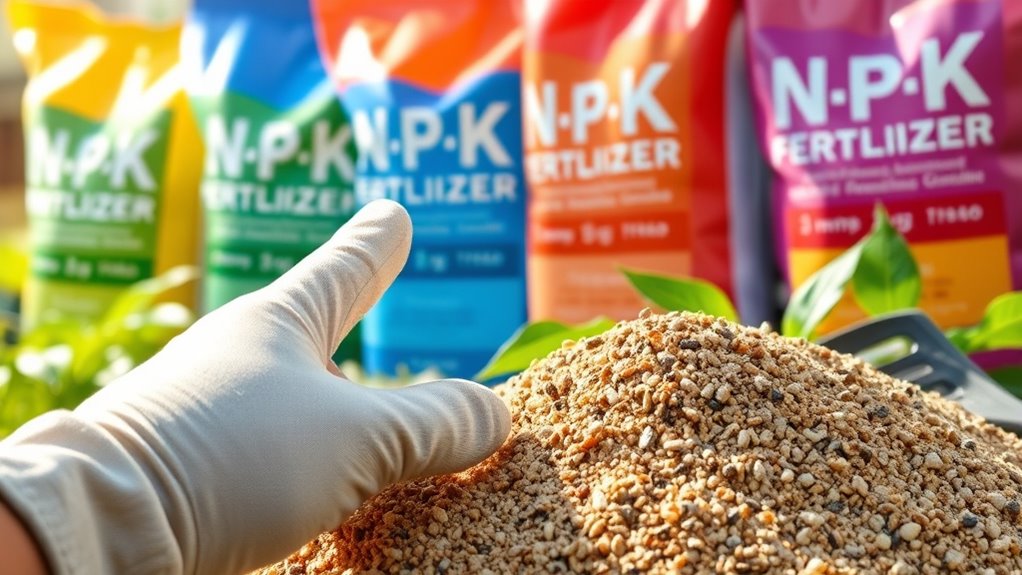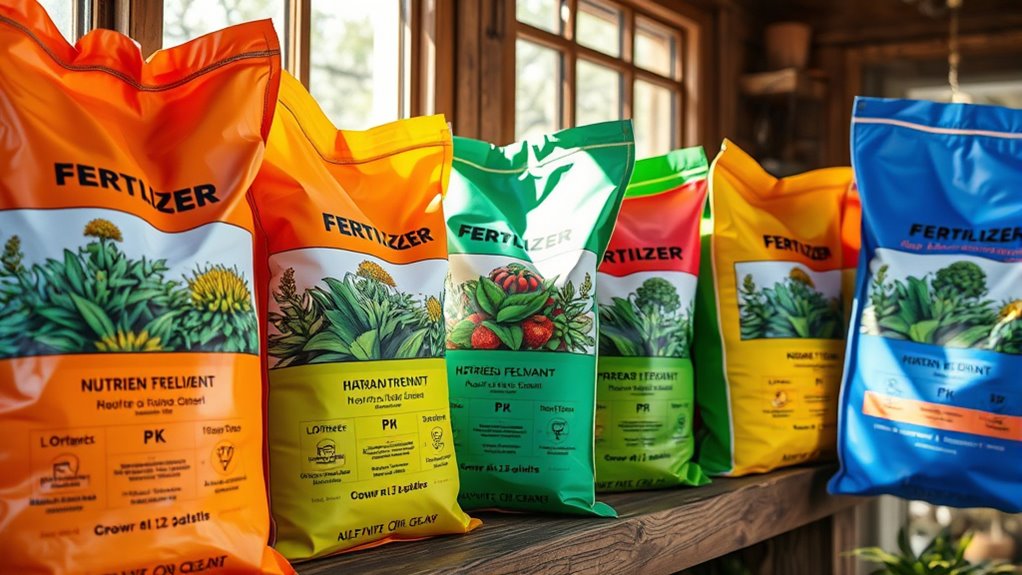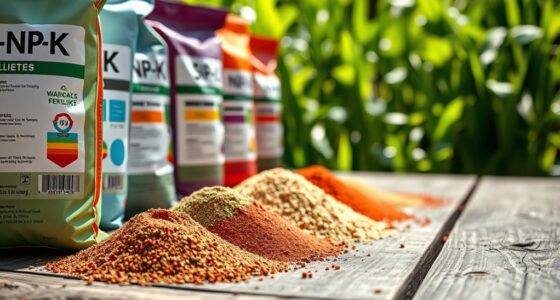Understanding N-P-K on fertilizer labels shows the three primary nutrients: nitrogen (N), phosphorus (P), and potassium (K). These numbers indicate their percentage in the fertilizer and help match your plants’ needs. For example, leafy greens need more nitrogen for lush growth, while flowering plants benefit from higher phosphorus. Knowing how to interpret these ratios helps you choose the right fertilizer for healthy, thriving plants. Keep exploring to learn how to tailor nutrients for every stage of growth.
Key Takeaways
- N-P-K ratios on fertilizer labels indicate the percentages of nitrogen, phosphorus, and potassium, the primary nutrients plants need.
- Nitrogen promotes leafy, green growth; phosphorus supports root development and flowering; potassium boosts overall plant health.
- Match fertilizer ratios to plant growth stages: high nitrogen for foliage, higher phosphorus for flowering and fruiting.
- Organic fertilizers release nutrients slowly, improve soil health, and support beneficial soil microorganisms.
- Using the right N-P-K ratio prevents deficiencies, enhances plant development, and promotes sustainable gardening practices.

Have you ever wondered how plants thrive and produce bountiful yields? The secret lies in understanding what they need and how to provide it. One essential aspect is soil health. When your soil isn’t quite up to par, adding soil amendments can make all the difference. These are substances mixed into the soil to improve its physical properties, nutrient content, or biological activity. Organic fertilizers are a popular choice because they enrich the soil naturally, releasing nutrients slowly and improving soil structure over time. Unlike chemical fertilizers, organic options like compost, manure, and bone meal boost the soil’s organic matter, helping microorganisms thrive and making nutrients more available to your plants.
Knowing what your plants need starts with understanding the essential nutrients. N-P-K—nitrogen (N), phosphorus (P), and potassium (K)—are the primary macronutrients that plants require in large amounts. Each element plays a specific role: nitrogen fuels lush, green growth; phosphorus encourages strong root systems and flowering; potassium enhances overall plant health and resistance to disease. When choosing fertilizers, you’ll see labels with numbers like 10-20-10, indicating the percentage of each nutrient. Matching these ratios to your plants’ growth stage and needs guarantees ideal development. For example, leafy vegetables benefit from higher nitrogen, while flowering plants thrive with more phosphorus.
Additionally, maintaining soil health through soil microbiome support is crucial, as beneficial microorganisms help break down organic matter and facilitate nutrient uptake by plants. However, relying solely on synthetic fertilizers might give quick results but can harm your soil over time. That’s where organic fertilizers and soil amendments shine—they improve soil fertility sustainably. Organic fertilizers not only supply nutrients but also enhance microbial activity, which helps plants absorb nutrients more efficiently. Incorporating compost or aged manure into your soil acts as a natural fertilizer and soil amendment, enriching the soil organic matter and promoting a healthy ecosystem underground. These amendments gradually release nutrients, reducing the risk of over-fertilization and runoff, which can damage your environment.
Understanding the balance of nutrients and the role of soil amendments can transform your gardening approach. Instead of simply adding chemical fertilizers, focus on building a healthy soil environment first. Use organic fertilizers to supply nutrients gradually and improve soil structure, and supplement with soil amendments to correct deficiencies and enhance soil life. This integrated approach guarantees your plants get what they need to grow strong and produce abundant yields. By paying attention to soil health and nutrient balance, you’re setting the foundation for a thriving garden that’s both productive and sustainable.
Frequently Asked Questions
How Do I Determine the Right Fertilizer for My Specific Plant Types?
To find the right fertilizer for your plants, start by evaluating their specific needs through soil testing. This helps you understand the current nutrient levels and deficiencies. Once you know your soil’s condition, match the fertilizer’s nutrient ratios to your plants’ requirements. Different plants have unique needs, so adjusting your fertilization based on soil tests ensures healthy growth and avoids over-fertilizing.
Can Over-Fertilizing Harm My Plants or the Environment?
Think of your plants like delicate dancers; over-fertilizing can throw them off balance. Yes, it can harm your plants by causing root burn and nutrient imbalances. More worryingly, excess fertilizer can wash away with rain, leading to fertilizer runoff that pollutes soil health and nearby water sources. To keep your garden thriving, follow recommended guidelines and avoid giving more than your plants need.
Are Organic Fertilizers Better Than Synthetic Ones?
You might wonder if organic fertilizers are better than synthetic ones. Organic options often improve soil nutrition naturally and support fertilizer sustainability, making them eco-friendly choices. They release nutrients slowly, reducing runoff and environmental impact. Synthetic fertilizers can provide quick nutrient boosts but may harm soil health over time. Ultimately, choosing organic fertilizers helps maintain a balanced ecosystem while nourishing your plants effectively.
How Often Should I Fertilize Indoors Versus Outdoor Plants?
You should fertilize indoor plants every 4-6 weeks, adjusting based on watering frequency and plant needs, while outdoor plants typically need fertilizing every 4-8 weeks during the growing season. Pay attention to fertilizer application timing, ensuring you don’t overdo it, especially indoors where watering frequency may be lower. For outdoor plants, fertilize when actively growing, usually in spring and summer, for healthy, vibrant growth.
What Signs Indicate My Plants Need More or Less Nutrients?
You’ll notice plant deficiency signs like yellowing leaves, stunted growth, or leaf drop, which indicate your plants need more nutrients. Conversely, dark, overly lush foliage might signal a nutrient imbalance, risking overfeeding. Pay attention to these symptoms to adjust your fertilizing schedule. Proper observation helps prevent deficiencies and imbalances, ensuring your plants stay healthy and vibrant. Regular checks help you fine-tune feeding and promote ideal growth.
Conclusion
Understanding N-P-K ratios helps you choose the right fertilizer for your plants. Remember, over-fertilizing can harm your garden, so always follow recommended guidelines. Did you know that using the correct fertilizer can boost plant growth by up to 30%? By paying attention to these nutrients, you’ll give your plants what they need to thrive. Keep learning, experiment wisely, and enjoy a lush, healthy garden all season long!









